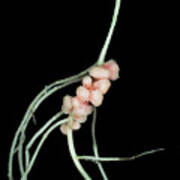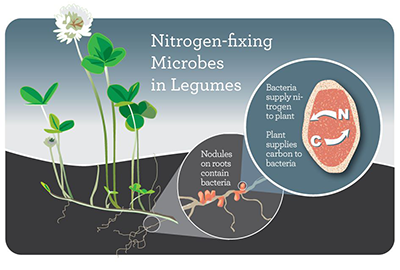Rhizobia: Difference between revisions
No edit summary |
|||
| Line 27: | Line 27: | ||
|} | |} | ||
Rhizobia are not confined to a single genus, as they span multiple genera: Rhizobium, Ensifer, Mesorhizobium, Bradyrhizobium, and Azorhizobium [ | Rhizobia are not confined to a single genus, as they span multiple genera: Rhizobium, Ensifer, Mesorhizobium, Bradyrhizobium, and Azorhizobium [4]. The ability to fix nitrogen and form nodules is determined by symbiosis-related genes, which can be transferred between species [4]. A characteristic of rhizobia belonging to the family Rhizobiaceae is their genome organization in multireplicons and their phenotypic distinctive characteristics in extrachromosomal replicons [4]. | ||
==Ecology and Habitat== | ==Ecology and Habitat== | ||
Rhizobia live in various environments, including soil, [[plant roots]], infection threads, and legume nodules at different stages [ | Rhizobia live in various environments, including soil, [[plant roots]], infection threads, and legume nodules at different stages [2]. | ||
==Symbiotic Relationship with Legumes== | ==Symbiotic Relationship with Legumes== | ||
[[File:Rhizobium_and_Legumes.png|400px|thumb|left]] | [[File:Rhizobium_and_Legumes.png|400px|thumb|left]] | ||
The symbiosis between rhizobia and legumes begins with a signal exchange between the host and plant and its microsymbiont, where the host induces cell divisions to form root nodule primordia, and simultaneously initiates an infection process to deliver the bacteria into the nodule cells [ | The symbiosis between rhizobia and legumes begins with a signal exchange between the host and plant and its microsymbiont, where the host induces cell divisions to form root nodule primordia, and simultaneously initiates an infection process to deliver the bacteria into the nodule cells [5]. [[Root hairs]] then curl around the bacteria, forming infection threads that guide rhizobia into the root, where they are enclosed in membrane-bound structures called symbiosomes, where the bacteria transforms into nitrogen-fixing bacteria [5]. This symbiotic relationship is highly specific because no single rhizobial strain can form symbiosis with all legumes, and compatibility varies at species and genotypic levels [5]. | ||
Through their symbiotic relationship with legumes, they enhance the availability of nutrients by breaking down [[Organic Matter|organic matter]] and releasing the nutrients into the soil [ | Through their symbiotic relationship with legumes, they enhance the availability of nutrients by breaking down [[Organic Matter|organic matter]] and releasing the nutrients into the soil [3]. Rhizobia and legumes work together to promote the growth of numerous plant species, thus strengthening the ecosystem [3]. | ||
==Soil Benefits== | ==Soil Benefits== | ||
Nitrogen is an important nutrient for plant growth and development, but plants do not have the ability to use the nitrogen in the atmosphere directly [ | Nitrogen is an important nutrient for plant growth and development, but plants do not have the ability to use the nitrogen in the atmosphere directly [4]. Rhizobium forms symbiotic relationships with legume plants by developing root nodules, where it converts the nitrogen in the atmosphere into a form that plants can absorb [4]. This process improves soil health by increasing nitrogen availability, contribute to increased soil microbial [[diversity]], and improving soil structure. | ||
==Rhizobium Biotechnology== | ==Rhizobium Biotechnology== | ||
==References== | ==References== | ||
Revision as of 10:38, 31 March 2025

Rhizobia are Gram-negative bacteria that fix nitrogen in soil that aid in the growth and development of plants. Rhizobia can only fix nitrogen when associated with a plant that provides it with carbohydrates and are only associated with legumes, but not all legumes associate with rhizobia.
Taxonomy
| Domain: | Bacteria |
|---|---|
| Phylum: | Pseudomonadota |
| Class: | Alphaproteobacteria |
| Order: | Hyphomicrobiales |
| Family: | Rhizobiaceae |
| Genus: | Rhizobium |
Rhizobia are not confined to a single genus, as they span multiple genera: Rhizobium, Ensifer, Mesorhizobium, Bradyrhizobium, and Azorhizobium [4]. The ability to fix nitrogen and form nodules is determined by symbiosis-related genes, which can be transferred between species [4]. A characteristic of rhizobia belonging to the family Rhizobiaceae is their genome organization in multireplicons and their phenotypic distinctive characteristics in extrachromosomal replicons [4].
Ecology and Habitat
Rhizobia live in various environments, including soil, plant roots, infection threads, and legume nodules at different stages [2].
Symbiotic Relationship with Legumes

The symbiosis between rhizobia and legumes begins with a signal exchange between the host and plant and its microsymbiont, where the host induces cell divisions to form root nodule primordia, and simultaneously initiates an infection process to deliver the bacteria into the nodule cells [5]. Root hairs then curl around the bacteria, forming infection threads that guide rhizobia into the root, where they are enclosed in membrane-bound structures called symbiosomes, where the bacteria transforms into nitrogen-fixing bacteria [5]. This symbiotic relationship is highly specific because no single rhizobial strain can form symbiosis with all legumes, and compatibility varies at species and genotypic levels [5].
Through their symbiotic relationship with legumes, they enhance the availability of nutrients by breaking down organic matter and releasing the nutrients into the soil [3]. Rhizobia and legumes work together to promote the growth of numerous plant species, thus strengthening the ecosystem [3].
Soil Benefits
Nitrogen is an important nutrient for plant growth and development, but plants do not have the ability to use the nitrogen in the atmosphere directly [4]. Rhizobium forms symbiotic relationships with legume plants by developing root nodules, where it converts the nitrogen in the atmosphere into a form that plants can absorb [4]. This process improves soil health by increasing nitrogen availability, contribute to increased soil microbial diversity, and improving soil structure.